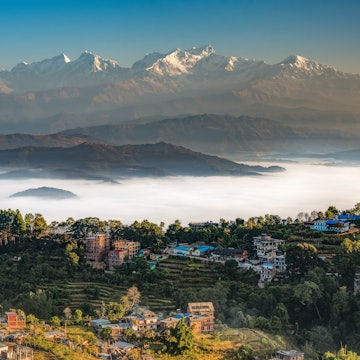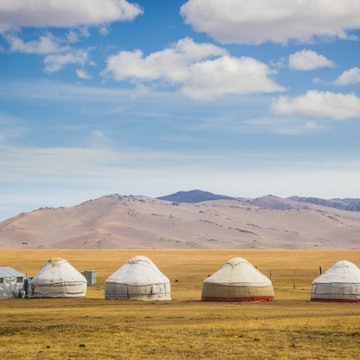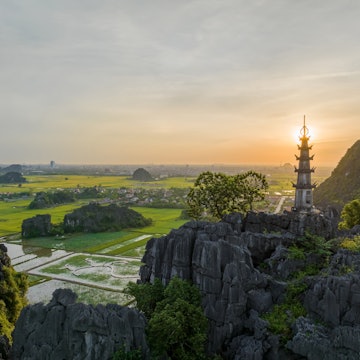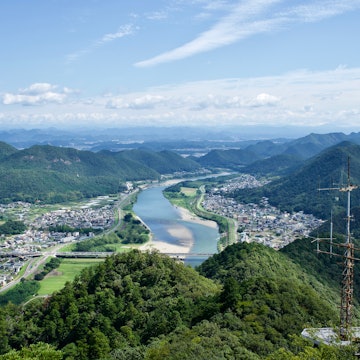
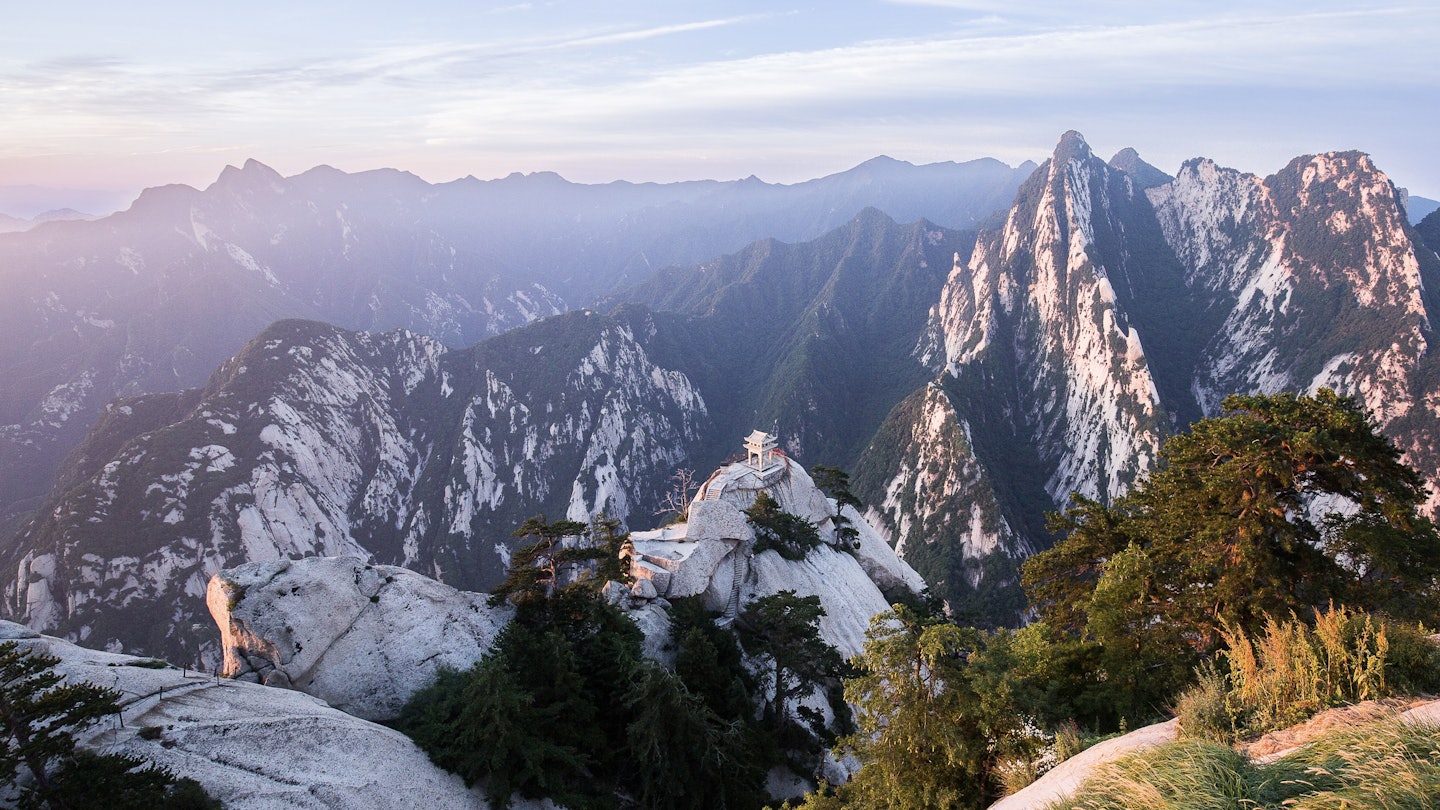
Sunrise over Hua Shan, Anhui. Germhess/Shutterstock
The continent-size country of China contains just about every type of landscape under the sun, from rainforests and grasslands to deserts and soaring plateaus – not to mention thousands of rivers and over 11,000 named mountains. Such geographically diverse places are home to complex ecosystems and a plethora of flora and fauna.
For decades, China’s spectacular natural assets have been open to visitors through hundreds of “national scenic areas” or “nature reserves” – often casually grouped and referred to as “national parks.” In recent years, to improve conservation China’s government has embarked on bringing different wildlife areas together under unified management. In 2021, the first five official national parks were launched, with six others currently under development.
Read on for a guide to these five pioneers, in addition to a few additional favorite scenic areas all over China.

1. Sanjiangyuan National Park, Qinghai and Tibet
Best for trekking in snow-leopard country
With peaks reaching up to 15,750ft (4800m), this vast high-altitude park is 14 times the size of the USA’s Yellowstone, and spreads across the sources of three great rivers: the Yangtze, the Yellow and the Lancang (the upper half of the Mekong). More than half of its 74,400 sq miles (190,100 sq km) sits on the Tibetan Plateau, where snow leopards, Tibetan antelopes and wild yak roam.
The huge reserve continues to be prepared for visitors, with improved accessibility and areas demarcated for mandatory protection – but tourist facilities are currently few. Still, it is possible to arrange a trek to the source of the Yellow River, following a trail that threads past grasslands, glaciers, alpine lakes and the Gobi Desert.

2. Giant Panda National Park, Sichuan, Shaanxi and Gansu
Best for encountering China’s quintessential animal
Endemic to China, the giant panda is the world’s rarest bear. Though no longer endangered thanks to decades of conservation and breeding efforts, the bamboo-munching cuties remain vulnerable – and as popular as ever.
This national park brings together 67 existing reserves scattered across Sichuan, Shanxi and Gansu that are home to over 1800 bears – about 80% of the species’ population in China. The aim of the consolidation is to ensure genetic diversity by enlarging habitats and hence the animals’ pool of potential mates. The Wolong Giant Panda Nature Reserve and the Ya‘an Bifengxia Panda Base, both in Sichuan and open to visitors, offer great opportunities to see and learn about China’s charismatic and elusive mascot.

3. Wuyi Shan National Park, Fujian and Jiangxi
Best for bamboo raft rides in the shadow of cliffs
The smallest of the five national parks is centered on Wuyi Shan, a mountain that’s a UNESCO World Heritage Site and Biosphere Reserve. The range lays claim to one of the world’s largest subtropical primordial forests, where relict plants and rare insects dwell. On the banks of the serene Nine-Bend Stream rise towering cliffs with hanging coffins, evidence of an ancient funerary custom; imperial ruins from the 1st century; and remnants of temples and academies from 1000 years ago, when Mt Wuyi was a cradle of neo-Confucianism. Bamboo rafting is popular here; there are also plenty of peaks to hike and caves to explore on foot.

4. Northeast China Tiger and Leopard National Park, Heilongjiang and Jilin
Best for hiking along the China–Russia border
Located in the Changbai Mountains along the border with Russia in Heilongjiang, this park and the breeding center that predates it have been successful in repopulating the critically endangered Amur tiger. Endemic to China, eastern Russia and North Korea, this magnificent animal is the world’s largest feline. Changbai villagers used to worship the big cats as “mountain gods,” before poaching, wars and development nearly rendered the species extinct.
Also prowling the parks’ thick woodlands are Amur leopards, Eurasian lynxes and golden eagles. Travelers can venture out on hikes in the park – though should know that the chances of spotting an elusive tiger are remote. Further south, along the China–North Korea border in Jilin, Changbai Shan Nature Reserve offers miles of forest, stark-blue crater lakes as well as skiing opportunities.

5. Hainan Tropical Rainforest National Park, Hainan
Best for stargazing in a rainforest
Incorporating several scenic areas and reserves in this southern island province, this luxuriant park is the home of the world’s rarest ape, the critically endangered Hainan gibbon – not to mention 39% of China’s bird species and thousands of wild plant types, too. As Hainan’s tropical rainforest contains many one-of-a-kind ecosystems, it is the world’s only remaining habitat for much of the endemic flora and fauna. Travelers can hike in mangrove forests, visit wildlife monitoring stations and gibbon-protection zones, and stargaze after night falls.

6. Wulong Karst National Geopark, Chongqing
Best for spelunking
About a two-hour drive from bustling Chongqing, this stupendous landscape is truly picture-perfect (indeed, Transformers: Age of Extinction was filmed here). Part of the UNESCO-listed South China Karst landscape, the park encompasses three main areas. Towering above a colossal sinkhole, the Three Natural Bridges are the world’s highest limestone arches. Furong Cave is a vast karst cavern with dripping stalactites and underground waterfalls. And a glass elevator lowers visitors down to Longshui Gorge, a plunging ravine cut by the flow of an ancient river. Wulong is off the map for most foreign travellers – except for those in the spelunking community, who flock to this globally famous caving spot.

7. Jiuzhaigou Scenic Area, Sichuan
Best for gem-like lakes on the Tibetan Plateau
This UNESCO World Heritage Site and Biosphere Reserve is one of China’s top-billed sights for good reason. Put simply, the Jiuzhaigou valley is otherworldly: transparent lakes; staggered waterfalls in turquoise, pearl, sapphire and other gem-like hues; and dark and intriguing woodlands – all set against the craggy, snow-capped peaks of a karst landscape. No wonder five million visit annually to hike the many trails and gawp at beauty. Jiuzhaigou means “nine-settlement valley,” referring to the nine Tibetan villages in the area, of which seven remain inhabited.

8. Hua Shan, Shanxi
Best for reenacting a martial-arts film
Hua Shan (elevation 2154m / 7067) is one of the five sacred mountains of Taoism. It’s also one of the most perilous climbs in all of China: imagine steep, narrow steps skirting precipitous drops, or a wooden plank bolted to the bare face of a sheer granite cliff. Hermits and Taoist mystics once lived here; ancient physicians once came to forage herbs for elixirs; and, in martial-arts novels, swordsmen duel on Huashan’s five peaks. The stark and ethereal scenery – not to mention the glimmer of danger – today draw lots of visitors, including many who make the ascent at night. For at sunrise, the views from the top are unmatched.

9. Zhangye UNESCO Global Geopark, Gansu
Best for surreally colored mountains
Known for its striking rust-colored mountains streaked with white, yellow, orange and soft lilac, this arid geopark lies at the foothills of Qilian Shan, whose eponymous national park is currently under development. Snow leopards freely roam these mountains – which play a pivotal role in the prevention of desertification as well as the conservation of glaciers and water in China’s western fringes. The preserve encompasses a sliver of oasis that once provided refuge to travelers along an ancient trade route known as the Hexi Corridor. Qilian Shan National Park will serve to rectify years of damage caused by administrative malpractice, and restore stressed ecosystems in areas of Gansu and Qinghai.

10. Huangshan, Anhui
Best for ink wash–painting vibes
Huangshan’s blend of jagged granite peaks and gnarly Buddhist pines peeking through the fog have seduced poets, painters and photographers for centuries. In fact, this UNESCO-listed place is a cradle of the shan shui (literally, “mountain water”) school of Chinese landscape painting. A maze of trails leads up and around the mountainside; hotels at the 6115ft (1864m) summit, some with natural hot springs to soothe travelers’ feet, make spending a night in the park an appealing option.

11. Zhangjiajie National Forest Park, Hunan
Best for CGI-worth landscapes
It’s not hard to see why Zhangjiajie inspired the luscious landscapes of the moon Pandora in the film Avatar – especially when the mist rolls in. The UNESCO Global Geopark is punctuated by 240 pillar-like sandstone peaks and over 3000 spires that have long been the stuff of legend. For millennia, this was a remote land known only to a few minority tribes and the hundreds of animal species that resided here (including the now critically endangered Chinese giant salamander, the world’s largest amphibian). The most astonishing views can be found at Yuanjiajie or Hallelujah Mountain, accessible via a glass elevator.

12. Dunhuang UNESCO Global Geopark, Gansu
Best for ancient Silk Road sculptures
The crown jewels of this park are the Mogao Grottoes, a World Heritage Site, and the bizarre yadan (or yardang) landform in the Gobi Desert. The Mogao caves contain one of the world’s most important collections of Buddhist art – hauntingly beautiful statues and murals that were made over the course of 1000 years, beginning in 366 CE. Of 735 caves in total, 20 are open to visitors, on a rotational basis; it’s obligatory to join a tour.
Some 125 miles (200km) to the northwest, in the Gobi Desert, the wind has sculpted a landscape of odd and elegant rock formations known as yadan. This area was once dubbed “Town of Demons,” as caravans were often led astray by the weird rocks and wind whistling through the passes and over the dunes. China has the world’s largest concentration of yadan – and the majority can be found here. The best way to take it all in is by joining a minibus tour.








